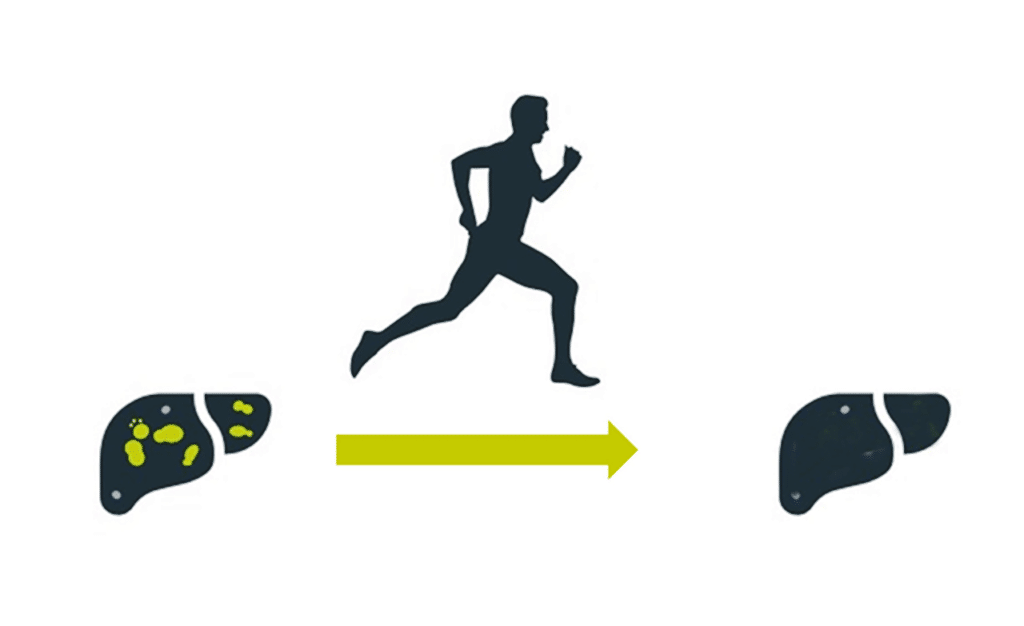Non-alcoholic fatty liver disease (NAFLD) is the most prevalent hepatic pathology associated with the global obesity pandemic. NAFLD is the leading risk factor for non-alcoholic steatohepatitis (NASH) and liver cirrhosis. It is closely linked to the development of hepatocellular carcinoma. In addition, NAFLD is associated with increased mortality.
An imbalance between energy intake and consumption is discussed as a cause for the disease. This leads to fat deposits in the liver and, over time, impairs the mitochondria function – both risk factors for the development of hepatic insulin resistance and liver inflammation. NAFLD is now one of the significant health burdens with tremendous consequences for health care systems and the individuals’ quality of life. It affects almost 1 out of 4 in the global population.
Health organizations worldwide advocate increased regular physical activity as a potential treatment of NAFLD and the prevention of steatohepatitis and associated metabolic comorbidities.
All kinds of exercise interventions (e.g., endurance and resistance exercise, a combination of both, or unstructured increase in daily physical activity) effectively alleviate NAFLD.
Scientists at the Institute of Clinical Chemistry and Pathobiochemistry at Tübingen University Hospital and the Institute of Diabetes Research and Metabolic Diseases (IDM) of Helmholtz Munich at the University of Tübingen investigated to what extent regular Exercise alters the adaptation of the liver to increased energy intake and what role skeletal muscle plays in this process.
The researchers collaborated with the Institute of Experimental Genetics (IEG) at Helmholtz Munich, the Leibniz Institute for Analytical Sciences in Dortmund, and the Dalian Institute of Chemical Physics in China.
Highlights of Study:
- High-energy diet promotes mitochondrial respiration in the liver independent of training.
- High-energy diet combined with training disconnects substrate oxidation from lipid synthesis.
- High-energy diet combined with training reduces complex I formation in the liver.
- Trained skeletal muscle unburdens the liver from substrate overload.
- Comprehensive resource of mitochondrial adaptations to high-energy diet and training.
Exercise can prevent fatty liver disease caused by overnutrition.

In the study conducted by Dr. Miriam Hoene and Dr. Lisa Kappler, mice were fed a high-energy diet. Some of the mice also received regular treadmill training. Following the six-week intervention, the researchers examined the animals’ livers and muscles for changes in the transcriptome, the mitochondrial proteome, lipid composition, and mitochondrial function.
The results showed that training regulated necessary glucose and fructose degradation enzymes in the liver and the mitochondrial pyruvate metabolism. In this way, the substrate burden for mitochondrial respiration and lipid synthesis can be reduced. Consequently, less fat is stored in the liver – and specific lipids such as diacylglycerol species are lowered.
Moreover, glucose control improves in the exercise-trained mice. In addition, an increased respiratory capacity of the skeletal muscles relieves the metabolic stress in the liver.
The systems biology data offer a comprehensive insight into the molecular adaptation of the liver and muscles to a high-energy diet, training, and combinatorial effects.
“The results fit in very well with the approaches of ongoing clinical studies in which inhibitors are tested against some of the targets found here, such as the mitochondrial pyruvate transporter,” said DZD scientist Prof. Dr. Cora Weigert, head of the study and professor of molecular diabetology at Tübingen University Hospital. “They also show that regular physical activity regulates many targets at the same time key nodes of metabolic pathways, an effect that cannot be achieved with monotherapy.”
Journal Reference
- Miriam Hoene, Lisa Kappler, Laxmikanth Kollipara, Chunxiu Hu, Martin Irmler, Daniel Bleher, Christoph Hoffmann, Johannes Beckers, Martin Hrabě de Angelis, Hans-Ulrich Häring, Andreas L. Birkenfeld, Andreas Peter, Albert Sickmann, Guowang Xu, Rainer Lehmann, Cora Weigert. Exercise prevents fatty liver by modifying the compensatory response of mitochondrial metabolism to excess substrate availability. Molecular Metabolism, 2021; Vol 54: 101359 DOI: 10.1016/j.molmet.2021.101359
